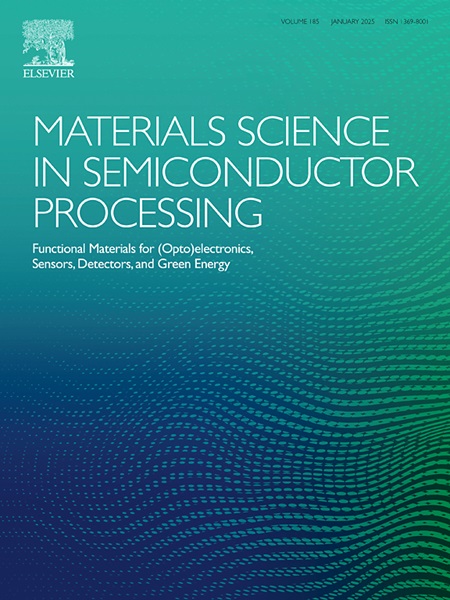The incorporation of Cs and K into the crystal structure of Rb2SnBr6 double perovskite: A DFT perspective
IF 4.2
3区 工程技术
Q2 ENGINEERING, ELECTRICAL & ELECTRONIC
引用次数: 0
Abstract
This study aims to investigate the effects of incorporating cesium (Cs) and potassium (K) into the crystal structure of Rb2SnBr6. The structural, mechanical, and optoelectronic features of both the parent and derived compounds were calculated using DFT whereas their thermoelectric properties were evaluated using the BoltzTraP code. The optimized lattice parameter of Rb2SnBr6 was found to be 11.01 Å. The results also indicated that the incorporation of Cs (K) into the structure of Rb2SnBr6 increases (decreases) its lattice parameter to be 11.13 Å (10.94 Å). The compounds are predicted to possess chemical stability as indicated from their negative formation energy. In addition, their calculated elastic parameters satisfy the Born-Huang stability criteria and their elastic tensors are all positive, implying their mechanical stability. The results also showed that when Cs and K are introduced into the crystal structure of Rb2SnBr6, its brittle behavior slightly reduces and the ductile behavior grows in some direction, making them more flexible in various applications. The introduction of Cs and K was also found to widen the band gap of Rb2SnBr6 perovskite. The values of PBE bandgap of Rb2SnBr6, CsRbSnBr6, and KRbSnBr6 are 1.28 eV, 1.94 eV, and 2.01 eV while those of SCAN are 1.58 eV, 1.94 2.27 eV, and 2.34 eV, respectively. Furthermore, their remarkable optical properties including high absorption coefficient and low reflectivity ensured their potential applications for various applications including wide-band gap perovskite solar cells. The results also revealed that the incorporation of K into Rb2SnBr6 crystal structure improves its thermoelectric properties between 50 K and 500 K. The highest ZT values of KRbSnBr6, Rb2SnBr6, and CsRbSnBr6 are 0.766 (at 100 K), 0.749 (at 800 K), and 0.746 (at 800 K), respectively. This highlights their potential for thermoelectric applications.
在 Rb2SnBr6 双包晶石晶体结构中加入 Cs 和 K:DFT 透视
本研究旨在探讨在 Rb2SnBr6 晶体结构中加入铯(Cs)和钾(K)的影响。使用 DFT 计算了母体和衍生化合物的结构、机械和光电特性,并使用 BoltzTraP 代码评估了它们的热电性能。结果还表明,在 Rb2SnBr6 的结构中加入 Cs (K) 会增加(减少)其晶格参数,使其达到 11.13 Å (10.94 Å)。这些化合物的负形成能表明它们具有化学稳定性。此外,它们计算出的弹性参数符合 Born-Huang 稳定性标准,而且它们的弹性张量均为正值,这意味着它们具有机械稳定性。研究结果还表明,在 Rb2SnBr6 晶体结构中引入 Cs 和 K 后,其脆性略有降低,而韧性在某些方向上有所增加,从而使其在各种应用中更具柔性。研究还发现,Cs 和 K 的引入拓宽了 Rb2SnBr6 包晶的带隙。Rb2SnBr6、CsRbSnBr6 和 KRbSnBr6 的 PBE 带隙值分别为 1.28 eV、1.94 eV 和 2.01 eV,而 SCAN 的 PBE 带隙值分别为 1.58 eV、1.94 2.27 eV 和 2.34 eV。此外,它们还具有显著的光学特性,包括高吸收系数和低反射率,这确保了它们在包括宽带隙过氧化物太阳能电池在内的各种应用中的潜力。研究结果还显示,在 Rb2SnBr6 晶体结构中加入 K 能改善其在 50 K 至 500 K 之间的热电性能。KRbSnBr6、Rb2SnBr6 和 CsRbSnBr6 的最高 ZT 值分别为 0.766(100 K 时)、0.749(800 K 时)和 0.746(800 K 时)。这凸显了它们在热电应用方面的潜力。
本文章由计算机程序翻译,如有差异,请以英文原文为准。
求助全文
约1分钟内获得全文
求助全文
来源期刊

Materials Science in Semiconductor Processing
工程技术-材料科学:综合
CiteScore
8.00
自引率
4.90%
发文量
780
审稿时长
42 days
期刊介绍:
Materials Science in Semiconductor Processing provides a unique forum for the discussion of novel processing, applications and theoretical studies of functional materials and devices for (opto)electronics, sensors, detectors, biotechnology and green energy.
Each issue will aim to provide a snapshot of current insights, new achievements, breakthroughs and future trends in such diverse fields as microelectronics, energy conversion and storage, communications, biotechnology, (photo)catalysis, nano- and thin-film technology, hybrid and composite materials, chemical processing, vapor-phase deposition, device fabrication, and modelling, which are the backbone of advanced semiconductor processing and applications.
Coverage will include: advanced lithography for submicron devices; etching and related topics; ion implantation; damage evolution and related issues; plasma and thermal CVD; rapid thermal processing; advanced metallization and interconnect schemes; thin dielectric layers, oxidation; sol-gel processing; chemical bath and (electro)chemical deposition; compound semiconductor processing; new non-oxide materials and their applications; (macro)molecular and hybrid materials; molecular dynamics, ab-initio methods, Monte Carlo, etc.; new materials and processes for discrete and integrated circuits; magnetic materials and spintronics; heterostructures and quantum devices; engineering of the electrical and optical properties of semiconductors; crystal growth mechanisms; reliability, defect density, intrinsic impurities and defects.
 求助内容:
求助内容: 应助结果提醒方式:
应助结果提醒方式:


